…I always feel like somebody’s watching me…
Facial recognition cameras, masks and the global development of totalitarianism from China to the rest of the world
The first few paragraphs were added or re-written a bit on 10/4/20 to relate to the present Coronacrisis. Though here and there I’ve added comments relevant to the current global situation, most of the rest of this article was completed in December 2019 before this crisis. Obviously just because we’ve now entered what effectively is a new epoch, does not at all mean everything before 2020 is now suddenly irrelevant….on the contrary.
However, some aspects of this text are outdated. Totalitarianism, “democratic” or not, is now imposed in such an insane manner that aspects of how and why facial recognition cameras are justified and used in utterly petty situations have been massively superseded by present state-imposed terror. Suffocatingly irrational restrictions on the most banal pleasures designed primarily to impose fear and accumulate money for the state (like fining people for swimming alone in the sea, ignoring totally the fact that the virus isn’t water-borne; like stopping sunbathing as if vitamin D doesn’t boost the immune system) are spreading as virulently as the virus.
23/8/19: destruction of Facial Recognition Cameras, Hong Kong
Some revolutionaries have suggested that with masks now becoming virtually omnipresent, that enables people to get away with whatever they want to get away with. But the all-pervading Coronacrisis does not automatically make masks a good pretext and method for such things. Anonymity is not guaranteed. Apparently even those wearing surgical masks can be identified by the latest in Facial Recognition Cameras (FRCs). Of course, we shouldn’t be too intimidated by this: it’s not that hard to put some kind of face-distorting mask or whatever under the masks supposed to protect people from this virus.
“A Chinese company says it has developed the country’s first facial recognition technology that can identify people when they are wearing a mask, as most are these days because of the coronavirus, and help in the fight against the disease.” The head of the company that has developed this has said, “When wearing a mask, the recognition rate can reach about 95%, which can ensure that most people can be identified”. Of course, his “can reach about 95%” already implies that there’s likely to be an element of hype in all this, but that remains to be seen (under the mask of capital’s omnipotence).
But what about this – from an article published on 7th April 2020:
“Clearview is the most powerful form of facial recognition technology ever created…. With more than 3 billion photos scraped surreptitiously from social media profiles and websites, its image database is almost seven times the size of the FBI’s. Its mobile app can match names to faces with a tap of a touchscreen. The technology is already being integrated into augmented reality glasses so people can identify almost anyone they look at. Clearview has contracts with Immigration and Customs Enforcement and the U.S. Attorney’s Office for the Southern District of New York, BuzzFeed reported earlier this year, and FBI agents, members of Customs and Border Protection, and hundreds of police officers at departments nationwide are among its users. With the coronavirus pandemic increasingly throwing the country into chaos and President Donald Trump moving to expand domestic surveillance powers ― in theory, to better map disease spread ― Clearview has sought deeper inroads into government infrastructure and is now in discussions with state agencies to use its technology to track infected people, according to The Wall Street Journal“ – from here.
Now, of course, the state wants to present itself as all-seeing and all-powerful in order to reinforce our sense of impotence in the face of an attack that, unopposed, will probably encompass all the vast variety of fragments of authoritarian despotism that have ever existed, now equipped with unprecedented technological means (for example Bill Gates has suggested that people should be made to have a digital ID showing their vaccination status, and that people without this “digital immunity proof” won’t be allowed to travel ). For capital and the state, the essential disease they want to fight is class struggle, the disease of all those who are surplus to its requirements, the requirements of surplus value.
**
On 23rd August, 2019, protesters in Hong Kong seriously damaged about 20 FRCs (see photos above). Partly as a result of this, on 26/8/19 there was a stunning victory in the fight against FRCs: “A Hong Kong technology company will stop supplying parts for the government’s “smart lampposts” after its executives and employees received threats. They also cited public concerns over surveillance as a reason to back out of the programme. TickTack Technology Limited on Sunday said that their commitment will be limited to supporting the 50 existing smart lampposts only. …. “We understand that disputes in society over the past few months led the public to be cautious and mistrustful towards some technology,” it said in a statement. According to the statement, the family members of company executives, as well as its employees, were personally threatened. TickTack Technology said they hope their withdrawal from the government contract would reassure the public. On Saturday, pro-democracy protesters targeted the 50 smart lampposts being piloted in Kwun Tong and the Kai Tak development zone, which were installed in June. Protesters expressed fears that the lampposts could enable a mainland-style surveillance system which would affect personal liberties. The government has said that the devices do not have any facial recognition functions and data will not be shared with third parties for identification purposes. During the Saturday protests, some demonstrators used electric saws to cut down lampposts and exposed the electronic components within. Local media reported that around 20 lampposts were damaged to varying degrees….” In fact, this company cancelled its contract to install an additional 350 of the same “smart lamp posts” throughout the city. So some kind of victory, even if partial, and probably temporary. Temporary unless we put an end the system that requires FRCs . Until then we are sadly reminded of this quote from the TV programme ‘The Outer Limits’ ‘‘The machines are everywhere! Oh you’ll find them all – you’re a zealous people. And you’ll make a great show of smashing a few of them. But for every one you destroy, hundreds of others will be built. And they will demoralise you, break your spirits…’’.
As the state prepared for anti-mask laws similar to France’s, one « legal expert » said: “The ability to use facial recognition to identify protesters will permit the [Hong Kong] government to track down dissidents and prosecute them once the dust settles”. But the dust hasn’t settled, even with the Coronacrisis (see Appendix at the bottom of this page). Ironic though that what were anti-mask laws are now being replaced in certain parts of the world by compulsory masking (also here and here).
Though this is probably the best form of mask:
**
« Losing face » is considered one of the worst humiliations in dominant Chinese culture; people would rather disown their own children, or cover up incestuous rapes by a family member, than « lose face ». This is pretty much everywhere also, but in Chinese character-culture it seems particularly developed. There used to be an adjective to describe typical Chinese people – « inscrutable » – ie the socially acceptable face that reveals and expresses nothing. Other national character traits are often similar, but in China it’s particularly embedded in the personality, possibly because of its long history of being relatively separate from external « foreign » influences, whilst sustaining the dominant mercantile character over a longer period of time than other countries, inscrutable poker faces hiding strengths and weaknesses, giving nothing away. Losing face is losing this facade – it reveals the truth behind the mask of dishonest normality, behind social relations mediated and obscured by image and the need for money. Losing facial recognition cameras is a significant practical truth behind the facade of normal alienation, subverting the modern state. Attacking them can be the beginning of the essential recognition – the recognition between individuals subverting their allotted submissive rôle within class society, mutual recognition in a community of struggle in opposition to recognition as a « good » or « bad » citizen by the market system and its states. Obviously nobody with a superior position in the social hierarchy suggested that people remove the “mask” of normality – the roles imposed by the system these superiors profit from, “masks” which are needed to hide their inner doubts, dreams, individuality and their capacity for mutual recognition. Losing this mask is like losing face. It’s losing the character armour needed to repress anger and desire, masks that everyone is forced to put on in order to sell their labour and not get sent to an asylum, prison, or Coventry, masks that keep us separate, masks that above all “protect” us against the anxiety of genuine communication whilst also avoiding recognising the absence of genuine communication. In the eyes of the cameras that reduce people to quantifiable 2-dimensions, the face is a unique mask sifting people into 2 simple categories – “illegal” and “legal”.
On October 4th the Hong Kong state banned the wearing of masks. 3 months or so later, with the virus, anybody who doesn’t wear one is considered a walking timebomb, a callous fool endangering their own life and that of others. Masks worn out of fear of prison and in defiance of the state, where people recognise each other in their opposition v. masks worn mainly out of fear of your fellow proletarian, where people only recognise each other as a potential threat to their survival. Back in autumn in Hong Kong, there was an irony in the fact that those people who were forced to wear masks to avoid arrest were beginning to overcome the socially-required “masks” conditioned by the permanent pressure of the system: “Hong Kong people are famously phlegmatic, unexpressive. We don’t talk much or effuse. But these days, we recognise something in each other, a common purpose, a common identity”, someone said about the social movement back then.
But now, masks shrink this common purpose to mere survival. “The more, and unscrupulously, humans have in mind their survival, the more they become psychological puppets of a system whose sole objective is to stay in power.” – Leo Löwenthal, 1946. In the current social context, masks inevitably intensify alienation and non-communication. Someone living in China recently wrote: “…wearing masks in public…might help slow the spread of the virus, but it also abolishes spontaneous interaction, no smiles, no greetings, no nothing. After two and a half months I really hate face masks, it just feels so depressing.” Regardless of their efficacy or not in combating what capitalism has turned into an epidemic, the massive reinforcement of character and character armour, the defences against communication, are turning this “plague” into an emotional plague.
The shrinking of common purpose
Doubtless one of the measures being discussed in ruling circles is how to deal with social unrest following the current forced domestication of the the vast majority. FRCs are a possible mass development they are considering. One of the essential aims of FRCs is the shrinking of public space (physical and otherwise) outside &/or against &/or parallel to the state – the elimination of such public space where a potentially free public deliberation, exchange and formulation of actions can occur (e.g. in Tiananmen Square prior to the massacre, but also anywhere people used to hang out on the street). All the states and all corporations have the same objectives. It is immaterial which country or which state. The deterioration of differentiating features and the global cooperation of their directing personnel (i.e. leadership) – a result of their necessary activity against similar obstacles around the world – shows us more and more that they are uniform in ethos and telos. And as part of our struggle for a free world, must be uniformly annihilated, along with the social relations they suck the life out of life with.
FRCs, like all forms of policing in this society, are invariably justified in terms of obvious, seemingly neutral, even beneficial, functions – such as their use as speed cameras, the ability to measure air quality, to monitor traffic flow, weather data or the dumping of industrial waste at blackspots, their ability to find missing children, etc. And now being used as a pretext to track people for “health” reasons: “If connected to a temperature sensor, it can measure body temperature while identifying the person’s name, and then the system would process the result, say, if it detects a temperature over 38 degrees” – here.
However, this company (which produces AI capable of analysing significant aspects of the human skeleton) mixes the usual forms of social control functions of FRCs and AI (including “multi-ethnicity recognition”!!) with claims that it can “design a live-action game based on the actions of real people”: Entertainment Macht Frei. Nice cop, nasty cop united together.
But of course, law enforcement ideologised by the dominant cliché ”If you’ve not done anything wrong you’ve nothing to be afraid of” is the main ideological justification for FRCs. (obviously, the current Coronacrisis has massively moved the goalposts of state-definitions of what “doing the wrong thing” means). The fabulous Aesop, the famous slave, said over 2500 years ago ‘We hang the petty thieves and appoint the great ones to public office’. But the modern child of apparent historical progress can only mouth ‘If you’ve done nothing wrong you’ve nothing to be afraid of, If you’ve done nothing wrong you’ve nothing to be afraid of, If you’ve done nothing wrong you’ve nothing to be afraid of’, as if the notions of ‘‘right” and “wrong” were obvious. Given that any rational notion of wrong would put at the top of the list of “wrong” those who make the laws that define their wrongs as ”right” (according to the logic ”Might makes right’‘) and anything lower down in the hierarchy of ”wrongs” as ”illegal”, this cliché clearly comes from ‘‘the great ones appointed to public office’’. On mainland China it seems that acceptance of this logic, despite the emptiness and impotence of daily life, is generally seen as positive by a submissive population. “I couldn’t tell which terrified me more: China’s all-encompassing network of facial recognition surveillance cameras, or that my countrymen were proudly cheering them on…Many people in China seem to be happy about the physical security promised by the surveillance network. Our mind-set, long ago, was wired to see safety and freedom as an either-or choice. Huawei’s Hong-Eng Ko put the public safety argument more bluntly this week, arguing that “if privacy wins, criminals win.” But this attitude is now, with the Coronavirus epoch, being taken up by “good citizens” throughout the world.
The final subhuman product of the system: docile spectators hoping to eradicate everything in themselves and in others that doesn’t reduce them more and more to the level of a predictable machine, who are nervous, even terrified, if they don’t think they are being supervised, deludedly dreaming of being defended by the very world that destroys all security, protected by the rulers’ protection racket. One of the first orders of any revolutionary movement is to make this type of subhuman impossible and to spare no instance in which they can be denounced, demeaned, denigrated, and subjected to condescending pity, while taking every pain to praise and encourage them at whatever acts of rebellion they may belatedly engage in, and understanding that this is something that regularly happens to all of us because it is embedded in the civilization that we must destroy. The first revolutionary act is disobedience. And with the current state insanity being currently imposed, “disobedience” has now been re-defined as the simple pursuit of the simplest pursuits.
Back just a few months ago, in Hong Kong, the forcing-of-submission function of FRCs, their use for an increasingly totalitarian society, was obvious to the protesters: “We feel unsafe, that’s why we have to speak up,” said Harry Yip, a school leaver, who said he wore a hat, reflective dark glasses and a black scarf to cover his face to avoid government surveillance. “Oppose surveillance, save Hong Kong!”, shouted some, while others cried: “Free Hong Kong!”, “Reclaim Hong Kong, revolution of our era!”…’’ (here). It’s of course the safety and security of class society and its rulers that FRCs ensure. FRCs are already being used by Hong Kong cops, where an Australian company has supplied the technology and secretly trained the cops in its use – “Hong Kong law enforcement authorities have access to artificial intelligence software that can match faces from any video footage to police databases, but it’s unclear if it’s being used to quell months-long pro-democracy protests, according to people familiar with the matter. Police have been able to use the technology from Sydney-based iOmniscient for at least three years, and engineers from the company have trained dozens of officers on how to use it, said the people, who asked not to be identified because the information isn’t public. The software can scan footage including from closed-circuit television to automatically match faces and license plates to a police database and pick out suspects in a crowd’’.
Global complicity
Collaboration with China’s FRCs is not confined to Australia. Canada too is complicit. And complicity is not confined to Canada and Australia, but also involves the United Nations: “Chinese tech giants are shaping United Nations’ standards for facial recognition as well as video monitoring…China’s telecommunications equipment maker ZTE, security camera maker Dahua Technology and the state-owned Chinese telecommunication company China Telecom are among those proposing new international standards in the UN’s International Telecommunication Union (ITU) for facial recognition, video monitoring, city and vehicle surveillance, said a Financial Times report on Monday. Standards ratified in the Geneva-headquartered ITU, which has 193 member states, are more often adopted as policies by developing nations in Africa, the Middle East and Asia, where the Chinese government has agreed to supply infrastructure and surveillance tech under its “Belt and Road Initiative”…Data from African countries is also very important to Chinese tech companies, which are seeking to improve their facial recognition especially for people of colour” (see, also, this)
And the USA is also complicit. Xinjiang is the area of the country with the biggest proliferation of FRCs, where over a million Uighurs have been placed in concentration camps labelled “vocational education camps”. Despite its Uighur Act of December 2019 imposing sanctions on China for its brutality towards Uighur Muslims in Xinjiang (basically using the Uighurs as convenient pawns in the US-China trade deals), much of the money for FRCs there has come from US pension funds: “Some of the biggest public pensions funds in the United States have invested in one of the world’s largest purveyors of video surveillance systems that the U.S. government claims are used in wide-scale repression of the Muslim population of western China”.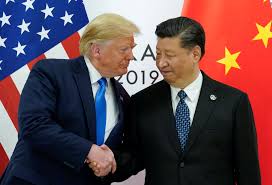
China is universally recognised as the world’s no.1 country in the production of the technological means of social control. Xinjiang is not the only area of China with massive amounts of FRCs by any means. FRCs are now being used for racial/racist surveillance not just in Xinjiang, but also in Beijing and other places: the multi-billion dollar Chinese company Hikvision, the world’s largest supplier of video surveillance products, has marketed an AI camera that automatically identifies Uighurs. What’s more, cops throughout China now have sunglasses with in-built facial recognition technologyi to facilitate the rulers’ law enforcement and facial recognition surveillance is apparently capable of picking out a wanted individual amongst a crowd of 60,000.
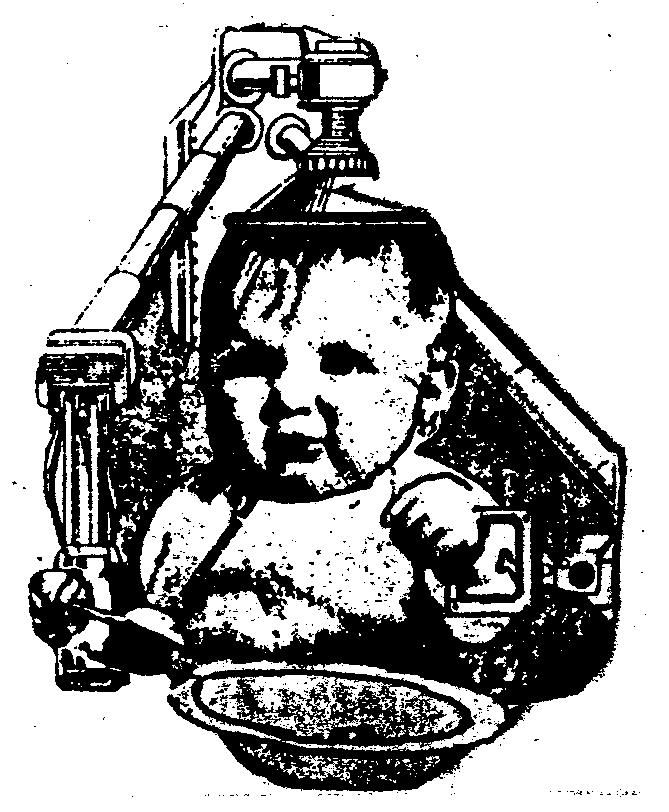

If the policing function of what passes for ‘education’ in this society wasn’t already implicit in the “vocational education camps” (ie concentration camps for the Uighurs), it’s shown in the rest of China by the fact that facial recognition cameras are now starting to be used in school classrooms because they can also recognise a person’s mood: anxious, furtive, scared, happy, disgusted, sad, surprised, angry, neutral, discombobulated or desperate-for-a-piss. “The system has been touted as a way to ensure students are attentive and happy, learning quickly and, ultimately, scoring well on tests.” This report shows the function for hierarchical power of classroom FRCs along with other forms of AI: “If students are smiling, greeting their teachers, taking the initiative to clean up trash, lining up neatly, or engaging in other good behavior; or if they are wrestling, fighting, crowding, or engaging in other dangerous acts, can be captured by artificial intelligence. Additionally, AI can also gather information on students’ seated disposition, hand-raising, standing, yawning, and other classroom behavior to analyze the status of a student’s learning process, their classroom efficacy, and their interest in learning.’’ Wonderful! And imagine how much more efficient such cameras would be with the current development internationally of e-learning. With kids being “taught” via the internet at home, something that will probably continue in some partial and modified form or another following this Coronacrisis, such cameras would be close-up, focussed on each pupil and impose an utterly isolated individualised form of “education” in which young people would potentially be conditioned to being increasingly incapable of communicating without the mediation of a camera and a screen.
19 years ago I wrote this:
“In the U.S. state of Michigan public funding has been awarded to a “school” that is no more than a computer/internet hook-up among kids being “schooled” at home. This “school” is organised around Christian Fundamentalist ideology…. the “school” hopes to instill in isolated vulnerable children respect before the altar of super slick scientific rationalism adorned with the archaic protection racket of sacrificial Christianity. When I first heard of this school I was utterly disgusted, but it’s a measure of how the bizarrely sick becomes banal that now I just think, “Oh well!”. Perhaps it’s also because this school is merely an exaggerated totalitarian extension and unification of all the more diffuse contradictions inherent in normal schools. Schools combine the most crass fuddy duddy moralism with the most Brand New technology in order to control and isolate kids, entice them into the tangled web of received ideas and bit by bit make them mutate into wage slaves. And in case anyone thinks the above mentioned school is a peculiarly American aberration, it needs to be pointed out that Birmingham city council, on the 5th of February 2001, drew up plans for pupils to be taught via internet video links as a way of coping with the teacher shortage. And since then, this is being projected as a “temporary” solution all over the country (though admittedly this is not in the isolation of the home).”
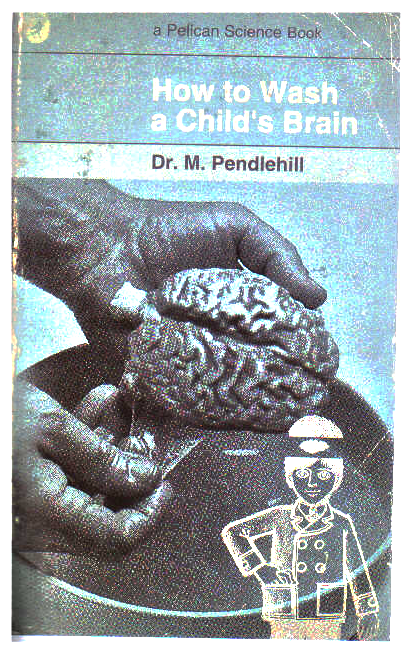
However, this report mentions a brave resistance to FRCs in some schools: “Last June, the Globe and Mail reported on public fears of a new form of state surveillance over facial recognition cameras trained to recognize students’ emotion at a Hangzhou high school, and this March Sixth Tone reported on students protesting by disabling similar cameras at a Beijing secondary school ahead of final exams.”Clearly, some Chinese people have not been so intimidated as to avoid speaking out against this suffocating development – ”This technology is so twisted. It’s anti-human,” said Zhang Jing, a 23-year-old photographer who spoke out online about the Hangzhou classroom. He envisioned a future where teachers demand students to smile in class and “then there’s no difference between students and robots, right?” (here).
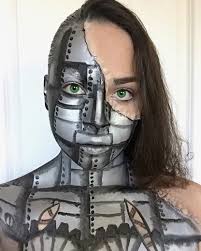





Spot the mood/emotion of the above:
a.excited b.exhilirated c.intoxicated d.inspired e.passionate f.enthusiastic…?
“Mood recognition” is now being touted as “emotion recognition’’ and is being used mainly at customs’ checks – “Using video footage, emotion recognition technology can rapidly identify criminal suspects by analysing their mental state . . . to prevent illegal acts including terrorism and smuggling,’’ said Li Xiaoyu, a policing expert and party cadre from the public security bureau in Altay city in Xinjiang. ‘We’ve already started using it.’ “The technology is mostly deployed at customs, he added, and identifies signs of aggressiveness and nervousness as well as stress levels and a person’s potential to attack others….” Significantly, ‘‘China is not the only country testing out emotion recognition capabilities, as companies including Google and Microsoft are also working on the technology. ...experts say in its current state, the technology doesn’t work very well. “This technology is still a bit of a gimmick,” FT cited a popular Chinese tech blogger as saying.’’ (here)
Cop Shops
China also now has unmanned shops where you pay through facial (and body) recognition cameras linked to your bank account, utterly repressing the economy’s problem of proletarian shopping (or shoplifting as dominant language puts it), and cutting out the “personal” touch of a labour force having to constantly repeat “May I be of assistance?”, conveniently along with the necessity of paying them wages. There are also certain areas where you can only get toilet paper if you’re on the facial recognition database, apparently aimed at preventing toilet paper theft and rationing toilet paper use. If Orwell’s 1984 had envisaged a world where Big Brother restricted how much paper you used to wipe your arse and knew how often you took a shit in a public toilet he would have been thought of as deliriously absurd and kind of comicly perverseii.
In parts of the country, facial recognition is used to shame the horrific crime of jaywalking, and to force people to pay jaywalking fines at copshops: “The public shaming has very visible effects …being publicly shamed could impact a person’s credit rating, as well as their insurance and pension premiums.” (see also this video).iii
However, it’s not just for obvious infringements on ruling class laws that China is developing FRCs. They’re being hyped up as also conducive to making a cleaner safer environment in lots of different ways (whilst also reducing the amount of wage labourers needed by the system) with Big Brother buildings watching how people shop and live: “Dalian Wanda Group upgraded its property management platforms at two Wanda Plazas by installing cameras that use behaviour-recognition technology to track shoppers’ movements inside the mall, such as how long a person lingers in a store and whether they walk out with a bag in their hand. The technology, from Wanda’s Huiyun management system, allows the group to capture and analyse a person’s age, gender and shopping patterns, letting the landlord better optimise merchant layouts. Shoppers don’t know it, but they’re also assigned a computerised ID so they’re recognised upon their next visit. Sensitive information, including people’s facial images, isn’t stored to prevent the risk of personal privacy infringement issues and potential legal disputes, the company says….the system has trimmed labour costs on facilities maintenance by as much as 62 per cent….What does Longfor do with the employees its technology has put out of work? The company uses them to provide next-level service for residents. An executive who travels a lot can ask these newly trained butlers to feed her fish while she’s away, or elderly people can be walked outside in their wheelchairs every morning. Residents can even rate these stewards, as Longfor calls them, using an app….First-time visitors can enter their mobile number at a fourth-floor screen to link to their WeChat account, giving Shui On access to their buying habits on Tencent Holdings, WeChat’s parent company. Immediately, discount coupons are sent direct to a person’s WeChat Pay wallet, making a cup of coffee cheaper or car parking free. The screen also offers brand suggestions based on previous shopping habits. The whole process is pared with facial recognition technology, so second-time visitors need only to stand still in front of the screen….video surveillance cameras capture footage three times a minute, gathering real-time pictures ranging from what guards are doing to whether non-residents are intruding upon private property….”. China is also developing the possibility of not just “smart buildings” but also of ”smart cities” – ‘China is home to roughly half of the world’s 1,000 pilot smart cities, which use 5G and AI technology to improve urban management.’ One of the main selling points of this system is that “they are more environmentally friendly since they can draw on multiple sources of renewable energy for power”. Without going into a critique of the greenwashing bullshit of so-called “green energy” – which is not the focus of this text – the main aspect of this is that it provides a method of surveilling electricity use within each living space and will be used to further control individuals to profit capital and industry. Yet it’s not just the new “smart” cities that are like some open prison: already around one-third of Shanghai’s over 10,000 apartment complexes have been secretly fitted with FRCs inside the buildings.
There are other developments in China: from December 1st 2019, facial recognition became a prerequisite for purchasing a mobile phone – ‘’MIIT said the step was part of its efforts to “safeguard the legitimate rights and interests of citizens in the cyberspace” and to control phone and internet fraud’’iv
As for ‘Mood recognition’ camera technology – it is not in any way confined to China but is being developed elsewhere, though not always directly in the form of legal or state-initiated repression but as a method of market research and consumer manipulation. “A supermarket might use it in the aisles, not to identify people, but to analyse who came in in terms of age and gender as well as their basic mood. It can help with targeted marketing and product placement.” (here)v. But there are, outside of China, also the usual ‘law enforcement’ uses for such Big Brother technology: “UK firm WeSee, for example, claims its AI tech can actually spot suspicious behaviour by reading facial cues imperceptible to the untrained eye. Emotions, such as doubt and anger, might be hidden under the surface in contrast to the language a person is using. WeSee says it has been working with a “high profile” organisation in law enforcement to analyse people who are being interviewed.” (same article). As if this wasn’t enough to maintain repressive social control, the Chinese state is now developing ‘gait recognition’: “…the system can identify people from up to 50 meters away, even with their back turned and their face covered. “Gait analysis cannot be fooled by simple limping, walking with splayed feet or hunching over, because we are analyzing all the features of an entire body”.
Analyzing the features of your own body
So, in relation to FRCs, awareness of how social control technology works can help you consciously alter your image and behaviour. Actors know full well that gait can be disguised by imitation of others and not just something you can disguise by the far-too-simple use of “limping, walking with splayed feet or hunching”. Actors know full well that mood can be consciously repressed, for example by recalling situations one has lived other than the real life actually being lived, or imagining and empathising other people’s situations. Such professional techniques can be used outside any professional career, in daily life, by those who have developed a certain self-consciousness, a distance from their own habitual facial expressions and body language, though of course, this reduces the element of spontaneity in resistance to external authority: one has to always calculate a risk well beforehand, though some aspects of calculation can become easy routine habits with constant repetition. As for FRC’s ability to see a discrepancy between one’s words and one’s micro-expressions, in certain circumstances/countries one can still refuse to talk to law enforcement agencies without being terrified and/or tortured. And refusing to be sucked into the dead-end of consumerism, and to predictable consumer habits, can enable people to avoid being seduced by “targeted marketing and product placement”.
Nevertheless, this remains a purely individual solution, necessary for one’s margin of well-being but hardly a solution. It’s still under siege to the watchful eye of the state constantly looking at every breath you take, every move you make, every step you take, every single day, every word you say, every game you play, every vow you break, every smile you fake, every claim you stake – the definitive police incessantly chanting “Can’t you see – you belong to me”. We’re under siege but not yet defeated, still capable of refusing to belong to the policed market “community”, even if we can’t avoid much of it despite our desires and the best will in the world: it’s an objectively-imposed force that has to be destroyed by an uprising of our intelligence, fury and disgust.
The People’s Republic of China has long had a tradition of surveillance, dating back to the Cultural Revolution of over 50 years ago, which was an imitation of the neighbourhood block committees dating from China’s imperial past over 1000 years ago. Of course, Mao ideologised this as “revolutionary” and “communist”. During the “cultural revolution” this method of social control – spying on your neighbours and denouncing them – was very labour intensive. Under Xi Jinping, backed by 50 years of capital accumulation and modernisation, technology vastly reduces the amount of labour needed to impose such social control. Such modern technology is tending towards state omniscient omnipresence, the materialisation of what in pre-capitalist societies was attributed to “God”: “The people have sharp eyes.”…This Communist Party slogan was heavily used during the Cultural Revolution, an era in which citizens were incentivized to spy on and even falsely accuse family and neighbors of being disloyal to authority. More than 50 years after that tumultuous era began, the slogan has been reincarnated in an ambitious and highly invasive surveillance program called Sharp Eyes (雪亮工程), one of the newer additions to China’s increasingly omnipresent surveillance state. This rural-focused initiative marries cutting-edge technology with Mao-era, crowd-sourced efforts by encouraging residents to surveil public video feeds and report suspicious incidents using their TVs and mobile devices…the transition to a more market-based economy means new means of control are now necessary….Sharp Eyes was officially launched in May 2015….Sharp Eyes was to be completed in rural regions by 2020, with “full coverage, network sharing, real-time availability, and full control.” Stated goals include 100% video surveillance coverage in key public areas and major industries (such as transportation, environmental protection, and urban management), new or upgraded HD cameras, full cross-network sharing of surveillance data, and government participation at all levels… this surveillance program… has been overshadowed by other programs such as the social credit system and the use of facial recognition to shame rule-breakers. In addition, by extending surveillance into rural areas, the program demonstrates how expansive Beijing’s aims are: to create a truly omnipresent surveillance state…Sharp Eyes builds upon Skynet by connecting existing public security camera networks that scan large public areas—such as roads, shopping malls, and squares—with private cameras at the entrances of residences and other buildings. Where Skynet aims for full public coverage, Sharp Eyes integrates public and private cameras into one large police network that feeds into local command and control centers…an “All Households are Monitors” [户户都是监控员”工程] project in 2015… involved upgrading the cable boxes on citizens’ televisions so that they could directly view surveillance feeds. This allowed citizens to report crimes by pressing a button on their remote control; a guiding propaganda slogan was, “Remote control in hand, safety in heart.”…the “Everyone is a Safety Officer” [“人人都是平安员”工程] project… was based on a mobile app that pushed video surveillance and public security information to citizens, and mobilized them to participate in public security prevention…. plans to eventually introduce behavioral analysis, which would be able to “predict vicious events,” allowing preemptive action. Similar behavior-based predictive policing programs are already being used in Xinjiang…Chinese surveillance systems overall are significantly hindered by bureaucratic inefficiencies… the Sharp Eyes system…appropriates household TV sets and smartphones to enhance the extension of surveillance systems to households and individuals…. A citizen told Bitter Winter: “The CCP is already monitoring us in our homes, what privacy do we have left? It’s like we’ve all got ropes around our necks and are being led on leashes. We’re all living under a microscope, and it’s terrifying.”
And this is being applied and extended “When a resident of Anxi village in China’s southwest Sichuan province set fire to a pile of rubbish two years ago, a loudspeaker barked his name and ordered him to put the blaze out. He extinguished the flames and scuttled away. He had been caught on a surveillance camera, monitored around the clock on one of 16 screens in the village security control room. The surveillance video in Anxi is also broadcast to cellphones and some televisions – placing busybodies on the front line of local security. People know they are always being watched. Fear of shaming is the essence of Sharp Eyes – or Xue Liang – a project being tested in 50 towns as part of what will become a nationwide system.”
Exactly the same project is also happening in Newark in the USA, mainly to police non-whites, it seems. As in China, this allows submissive spectators to watch the town’s CCTVs from the discomfort of their so-called “living” rooms. In the versionof this text which was completed before the Coronacrisis, I wrote: “Whilst this is limited to a small area for the moment, it shows how democracy is just a couple of steps behind totalitarianism…”. As totalitarianism hits the whole world post January 2020, we can see now how democracy and totalitarianism are virtually interchangeable, particularly as everywhere people are encouraged to grass up their neighbours for the most mionor “crimes” of infringement of the quarantine rules and willingly play the morally outraged “good citizen” prepared to send the cops to fine fellow proletarians whilst letting those who’ve destroyed hospital beds and created the conditions for such a pandemic to spread off the hook. Totalitarianism depends on people believing that, even if the rulers make mistakes, that despite their incompetence, everything is all right, that struggle is finished, that they can win a victory over themselves so as to love Big Brothervi.
As said earlier, apparently facial recognition surveillance is capable of picking out a wanted individual amongst a crowd of 60,000. However, one suspects that if the Chinese state via its cops gave this example such enormous publicity, it’s because so far this ability of FRCs is fairly rare; the story is meant to intimidate by example because fear-cum-threats is the biggest cop. Even when there’s much to really fear, the choice of giving in to fear destroys far worse than facing it, and the state’s exaggeration of its powers polices as much as, and sometimes more than, bullets. Fear of fear – the cop in your head.
The rulers invariably portray their power as far greater than it in fact is in order to induce resignation – the suffocating anti-life attitude of “why worry? – there’s nothing you can do about it” mentality that accepts impotence and ideologises it, justifies it, rather than strives to express some fundamental fury with some strategic channeling of this furyvii. Resignation is made to seem the best option, and certainly the easiest, the ever-narrowing line of least resistance. Hope, when it’s not coming from hope in some external authority, when it’s not the donkey chasing after the carrot, involves practical choices, an estimation of possibilities and their concomitant anxieties. In such practical ‘hope’ (ie possibility) the individual also comes to life, in striving to clarify and overcome difficulties and confront contradictions. Of course, individuals have to want to come to life, have to want to struggle against the power of submission. Information, such as provided here, about the weaknesses of FRCs is only useful for those people who want to express and extend their shrinking margin of freedom.
Information such as this (from the above article on “sharp eyes”): “Despite grand claims from Chinese state media on Sharp Eyes’ successes, an extensive report from IPVM on the program concludes that achieving “no blind spots” is “highly improbable.” It cites local officials and blueprints frankly admitting technical difficulties, inconsistent standards, and lack of adequate funds and professionals”. So FRCs are not invariably what hierarchical power makes them out to be.
However, celebrating their defects also makes no sense: their defects often have miserable consequences for the powerless, even worse than mugging of the poor by the nihilist decomposed sections of the poor utterly imbued with the dog-eat-dog ethos of the dominant class but deprived of their material means: “It is precisely the mad surveillance with video cameras in public places, in buses, even in classrooms, facial recognition at the subway entrance, voice identification, obligatory real-time monitoring of electric cars, etc., that is making the trade in personal data flourish. You can buy the geographical location or the personal data of a mobile phone number on the Internet for less than one euro. Every year the personal data of several hundred million Chinese people are published on the Internet, often they come from public institutions and official databases. These data breaches fuel many cases of fraud, which only make the headlines when a victim dies”. – here. And in relation to the previously mentioned new requirement of facial recognition for mobile phone users in China ‘‘One netizen said: “Previously, thieves knew your name, and now they will know how you look”…Another said that they often received scam calls from people who knew their name and address. They asked, “Can the scammer now tell what I look like?”.
Individual ‘solutions’
Outside possibilities engendered by mass struggle (as is happening now in Hong Kong) various, inevitably limited “solutions”, to the power of FRCs, have come to light. For instance, this report shows how FRCs were thwarted by a simple nosejob. This is not to suggest such an action other than in extreme circumstances (and not just because of the largely prohibitive expense) but it’s mentioned here to show that FRCs are not the all-powerful technology they’re made out to be. Other individual solutions have been suggested.
The ones below are just a way of selling “socially significant” art, a way of making a fast buck whilst appearing to be subversive:
As one DD correspondant wrote in relation to these kinds of suggestions: “[They’re] presented as stylised, fashionable, impractical and edgy rather than effecting the root of the problem”, which is all that art can ever do. They combine specialised “beauty” in an ugly world with the appearance of being a bit naughty and rebellious. They literally dress up middle class conformist complacency under the self-valorising self-identity of the “inventive interesting individual”, someone who’s a little bit anti-state, in a world where individuality is shrunk and narrowed into the constant search for a unique aesthetic image, the easiest and most socially acceptable way uniqueness is allowed to be expressed.
The following, however, is largely just advertising, since we discover at the end of it (in the smallprint, as it were) that it’s not as effective as it initially tries to make out it is: “…it’s nice to know there’s at least one way to fight back against all the systems designed to keep track of our comings and goings. Developed by Japan’s National Institute of Informatics, these glasses include eleven LEDs that blast a privacy curtain of near-infrared light to obscure your face. It’s invisible to the human eye, but to most cameras the near-infrared light will prevent facial recognition systems from registering the wearer’s face….Unfortunately the glasses won’t foil cameras that are unaffected by infrared light, but when used alongside an outrageous oversized Groucho Marx moustache, neither man nor machine should be able to pick you out in a crowd’’.
However, the most dubious individual “solution” to FRCs is this – “Scientists at China’s Fudan University are developing an invisibility mask that uses tiny infrared LEDs wired to the inside of a baseball cap to project dots of light on to the wearer’s face.” This article curiously avoids any scepticism about the reasons for this research, taking its self-justifications at face value. This may seem simply naive on the part of the journalist who wrote it, but such blind naivety has some material reasons: journalists rarely look behind the face/facade of social relations because doing so would undermine their own professional position within these relations. They value their job as essentially entertainers, providing “investigation” mainly to entertain their readers and give them a superficial feeling of having been informed, so upping their exchange value in the eyes of their bosses, the maintainers of the entertaining facade of a world and life ruled and destroyed by value in all its myriad forms, face value (the facade selling the commodity economy) as much as any other aspect of life reduced to value, to the quantifiable.
Let’s look at what’s probably behind this facade. Fudan University is China’s 3rd best university, the first institution of higher education to be founded by a Chinese person, probably as elitist as Oxford or Cambridge, Yale or Harvard, though not as ancient. It’s obviously financed by the state. Given that the Chinese state is the world’s no.1 country for the proliferation of FRCs, this research at Fudan University should not, as this article does, be presented as something that resists facial recognition, whether private or state. The chances are that, at best, it’ll be only available for use by the police, the army or other defenders of the totalitarian state, or by private security guards defending the increasing totalitarianism of the world market. Or even to be sold to the rich to give them free rein for their perverse pursuits. No need to worry about cameras taking photos of cops or undercover cops beating the shit out of protesters. Or bourgeois bastards being tracked frequenting nefarious scum. Masks forbidden for the undeserving poor, but ever more sophisticated masks for the super-rich and super-powerful. Maybe even Xi Jinping could wear one in order to avoid being recognised by potential future crowds hoping to do to him what Italians did to Mussolini on 28th April 1945, a way for him to avoid getting too highly strung. And perhaps the research is also being carried out in order to anticipate methods of avoiding facial recognition (such as the one mentioned above that uses LEDs) so as to combat these devices in advance of their proliferation.
Spreading in the ‘democracies’
FRCs are spreading into the “democracies” as well. The French state is trying to make access to online services (tax, health, etc.) dependent on you uploading onto a smartphone the application for the service of your “choice” and then getting the phone to read the chip in your ID card or passport. Finally, to activate the account, you have to apply a facial recognition device – ie a photo and a video with gestures which you perform in front of the phone’s camera, so as to check your identity (here). Another way of making smartphones virtually compulsory. But if people, bit by bitter bit, begin to accept these constraints it’s because bureaucracy has so invaded life that it appears to be natural and inevitable, sold by the state as essential for the “war against terrorism”. It’s also sold as a way of avoiding identity theft, and fear of identity theft overrules fear of Big Brother in most people. However, FRCs are not only very inaccurate, they’re also neither a defence against identity theft nor against non-state terrorism, as “Cybercriminals could…replace the face of a terrorist on a blacklist with that of an ordinary, innocent person.” (here).
As for the UKviii, “Facewatch [a major FRC production company] …has signed a deal with a major UK supermarket chain… and is set to roll out the system across their stores this autumn. On a conservative estimate, Fisher says, Facewatch will have 5,000 cameras across the UK by 2022. The company also has a contract with the Brazilian police…cameras have been tested by the Metropolitan police at Notting Hill carnival, a Remembrance Sunday commemoration, and at the Westfield shopping centre in Stratford, east London. This summer, the London mayor, Sadiq Khan, wrote to the owners of a private development in King’s Cross, demanding more information after it emerged that facial recognition had been deployed there for unknown purposes.’’ (here)ix. According to this article the South Wales police used FRCs at a peaceful protest in Cardiff against the arms trade. Liberal tut-tutting finger-wagging objections to all this remain within the dominant ideology of “policing by consent”, invariably complaining about symptoms but never the totalitarian disease of the all-pervading class-based commodity economy itself. They merely complain that most people haven’t agreed to this (yet)x. But it wouldn’t take much to manipulate the mass of spectators to such an agreement (eg a high-profile case of someone – a terrorist, for example – who would have been caught if there’d been FRCs around). The point, however, is that the biggest terrorists – those who run the economy – are getting away with mass murder legally (see, for instance, this report showing about 12,000 extra deaths in the UK directly caused by austerity). The head of Facewatch said in this article “if you’ve got something to be worried about, you should probably be worried”. Clearly the Brazilian cops with whom he’s got a contract – the cops who defend the ecocidal/genocidal maniac who runs the country – have nothing to worry about. Liberals complain “In contrast with DNA and fingerprint data, which normally have to be destroyed within a certain time period if individuals are arrested or charged but not convicted, there are no specific rules in the UK on the retention of facial images. The Police National Database has snowballed to contain about 20m faces, of which a large proportion have never been charged or convicted of an offence. Unlike DNA and fingerprints, this data can also be acquired without a person’s knowledge or consent.’’ As if lack of a conviction ever automatically led to the destruction of DNA or fingerprint data, as if DNA isn’t a con promoted by cops and forensic scientists (see this).
And FRCs are proliferating in “Serbia…Turkey, Russia, Ukraine, Azerbaijan, Angola, Laos, Kazakhstan, Kenya and Uganda, as well as a few liberal democracies like Germany, France and Italy. The system is used in some 230 cities.”…Huawei says its technology can scan over long distances to detect “abnormal behavior” such as loitering…and send alerts to a command center if it detects something suspicious.”
Pantic, a research director at Samsung AI Centre, Cambridge, said “the public overestimates the capabilities of facial recognition. In the absence of concrete details about the purpose of the surveillance in London’s King’s Cross this summer, newspapers speculated that the cameras could be tracking shoppers and storing their biometric data. Pantic dismisses this suggestion as “ridiculous”. Her own team has developed, as far as she is aware, the world’s leading algorithm for learning new faces, and it can only store the information from about 50 faces before it slows down and stops working. “It’s huge work,” she says. “People don’t understand how the technology works, and start spreading fear for no reason.” (here)
One might be relieved to hear this, but there are of course, good reasons for fear, even if fear is something not to be submitted to. Despite the danger of over-estimating such technologies, there’s also a danger in under-estimating them: it’s well-known that the thought of being constantly surveilled causes an enormous amount of stress, which wears and tears at each person (there are even some people who cover the camera on their mobile phones for fear of having their every activity monitored, even though they don’t even do anything or discuss anything illegal). One has to be constantly alert, constantly aware of how intruded upon by the ruling scum we are, constantly uncomfortable in the circumscription of life and the world. Some of course claim not to care, but even these, beneath the indifference to anything other than eventually completing their bucket list, can’t lie to themselves forever.
Of course, totalitarianism, no more than any other ism, is never a completed goal, never perfect and is always reinforced by resignation. Fortunately the human spirit can ignite even in the darkest of hours – there were even revolts in the Nazi’s concentration camps and in Stalin’s gulags (e.g. this). But it is certainly a process constantly capable of extension and intensification. Which is why Hong Kong’s resistance to it, however confused, sometime stupid and often naive, is something essential to encourage and be encouraged by, a movement to be influenced by so as to partly emulate.
– Sam Fanto, 4/12/19. Thanks to G. and his considerable input.
APPENDIX
The following are some of the events in Hong Kong following the start of the Coronacrisis:
23/3/20:
Petrol bomb attack at Hong Kong police married quarters
Hundreds commemorate 15-year-old Hong Kong student who died last September
22/3/20:
Yuen Long riot police take away many in repeated dispersals
16/3/20:
District councillor worker arrested after dispute over signs targeting gov’t supporters
8/3/20:
Cops seize homemade bombs, several arrests
29/1/20:
Clashes renewed on 6 months anniversary of cops beating the shit out of people in the underground
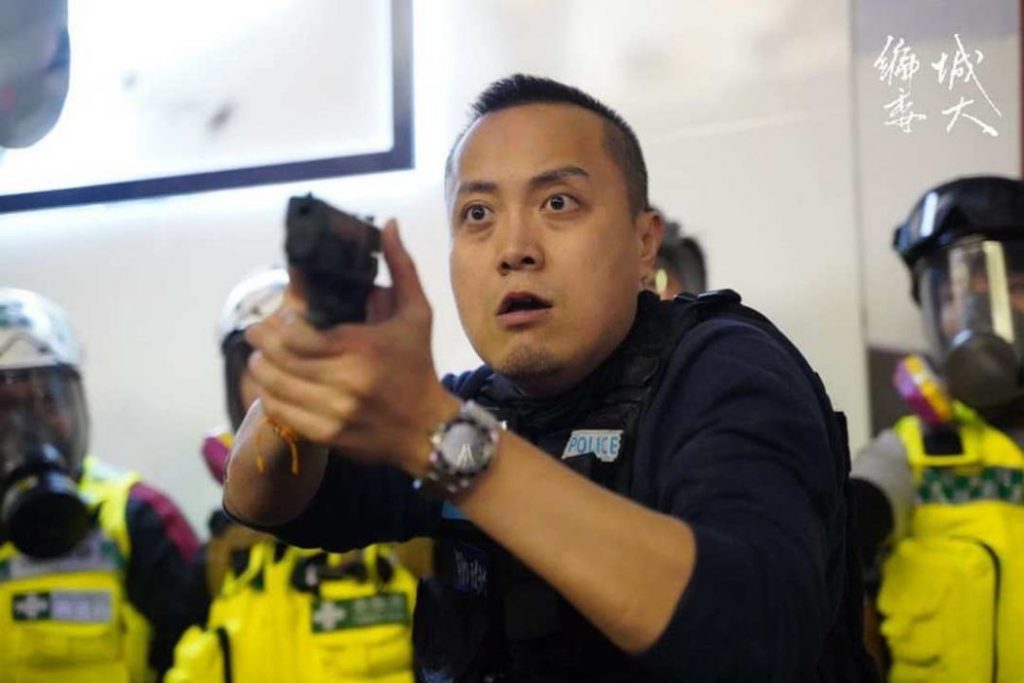 cop draws his gun saying the usual blah blah – “my life was threatened” by protesters throwing bricks, stones and bamboo sticks.
cop draws his gun saying the usual blah blah – “my life was threatened” by protesters throwing bricks, stones and bamboo sticks.
21/2/20:
Protesters celebrate cop’s Coronavirus infection with champagne & beer
“At the atrium of the Landmark shopping centre in Central, about 50 people gathered at 1pm, with some placing a dozen Corona beers on the ground to “celebrate the infection with the coronavirus of a police officer”.“Please feel free to take a beer and join our celebration,” a protester told passers-by.David Li, a protest co-organiser in his early 20s, said: “The police are now paying for their brutality in the past months in handling protests. We finally have something to be happy about amid the virus outbreak.””
19/2/20:
Anti-government protesters’ slogan spray-painted outside Chinese army base
15/2/20:
Barricades built, station torched, amidst anger over virus
“Protesters in Hong Kong returned to the streets at the weekend amid growing public anger over the city authorities’ handling of the coronavirus epidemic, with one group setting fire to a railway station and another damaging a local clinic. The protesters occupied Tin Sau Road in Tin Shui Wai district and built barricades with rubbish bins, wooden boards, foam boxes and debris to block multi-lane highways, the government said on Sunday. The demonstrations came after a group of people set fire to a ticket machine inside Tin Sau Light Rail (LRT) station on Saturday.”They even poured suspected flammable liquid onto the blaze,” the government said in a statement, adding that some protesters threw trash cans onto a track while a train was passing through in the other direction. Riot police were dispatched to the scene, where they surrounded around 20 black-clad protesters and ordered them to remove their masks and show their ID, firing pepper spray at them. At least 14 people were arrested. The government said the incident happened after an earlier, peaceful demonstration had ended.Riot police also gathered in Fo Tan, in the New Territories, along with an armored vehicle and a water cannon, ahead of a planned demonstration on Saturday afternoon. Another group marched in Tai Po against plans to use the local Tai Po Jockey Club primary care clinic as a center for “mild” COVID-19 cases, chanting slogans calling on the government to close down the city’s border with mainland China. They told reporters that there had been no consultation with local residents about the clinic before the plan was announced.”
12/2/20:
Arrests following road blockades
10/2/20:
Teachers who criticised government on social media say they are living in fear
7/2/20:
Thousands of doctors and nurses hold sit-in at Hospital Authority asking for negotiations on last day of strike; officials refuse to meet them
See also these reports:
Coronavirus: Hong Kong medics escalate strike to demand a full shutdown of Chinese border
Hong Kong Free Press, February 4, 2020
Hong Kong’s Striking Health Workers Pose New Threat to Beijing
Bloomberg, February 3, 2020
6/2/20:
Report on large increase in those joining Trade Unions
If course, this is not at all to defend the collaboration role of Trade Unions, but it gives the lie to those who dismiss the movement in HK as merely concerned with bourgeois democracy and not daily life issues such as wages and working conditions.
Footnotes
i This is not confined to totalitarian China. In the UK, South Wales cops are pushing forward with a new trial of a facial recognition app on officers’ mobile phones
ii Truth is stranger than fiction and even the best of satires is surpassed daily by a reality that increasingly seems to parody itself, which shows the limits of satire. Parodying the ever-accelerating development of a boundlessly mad normality, a madness that was seen as integral to normality, as something obvious to anyone with a splinter of sense 50 years ago (eg Kissinger getting the Nobel Peace Prize), has long been part of mainstream culture, hiding utter conformist complacency under a rebelious image. For example, Private Eye in the UK was, from its very beginning back in the early 60s, mostly run by cynical Tory voters from public schools even as it took the piss out of Tories and public schools. Satire for laughs, neither insightful nor inciteful. And the somber satire of Orwell himself, despite the usefulness of some of his insights stemming from an integrity a million light years away from the smug arrogant frivolous schoolboys of Private Eye, has long been prized as the epitome of British cultural excellence, used as an obligatory self-congratulatory pat on the back by an English culture long celebrated by the most dull and often most coldly vicious of its middle and upper class members (as well as sometimes their equivalents in other countries).
iii In Germany, the country whose history makes it probably the most well-renowned for its reputation of submission to authority, crossing the road when the little man is red will often get you booed and jeered at by pedestrian pedestrians. But the shame of jaywalking is nothing compared to the shame and subsequent disaster of pissing against the wall in Germany and the UK. 14-year-olds in these oh-so democratic countries can go on the sex register for exposure when having to relieve themselves, which can plague them for the rest of their lives (this is also the case in certain states of America). It’s an indication of intensified alienation, of the raising of the petty to the important and vice versa, that something that only bothered the most puritanical people in the past, and which by any sane standard should be considered in most circumstances pretty much ok (depending on where you piss), has now become a source of tension and contention.
iv For an interesting history of how smartphones in Xinjiang were initially a cheap way of developing a culture independent of Beijing and was then used to uncover those whom Beijing considered potentially a danger, see this. There’s a lesson here for all those innocents using their smartphones for XYZ ‘innocent’ communication. In this report, a typical Beijing ideologist (Liu Deliang, a law professor at Beijing Normal University) told China’s “Legal System Daily” that “technology is neutral and that users need to be managed. Face recognition technology cannot be viewed negatively, or scientific progress will be hindered.’’ As if “scientific progress” was neutral ho ho ho – tell that to the Uighurs.
v The supermarket chain Asda, in the UK, is starting to use FRCs to “ensure the safety of our colleagues, customers and visitors and for the prevention and detection of crime; investigate accidents and claims; (and) investigate potential breaches of Asda Policy.” (here). Good to know that supermarkets without FRCs are unsafe. Supermarkets in the UK are also starting to use FRCs to gauge whether those buying alcohol at automatic checkouts are underage or not. As if the constant problems with errors at these places aren’t bad enough, imagine a young looking 30-year-old having to try to constantly prove his/her age to a machine, I know someone in the States who, though 33 at the time, was constantly having to provide ID every time he bought a beer – but at least he had to do this to a human being. Though the advantage for young teenagers of this is that they can easily disguise themselves with grey or balding wigs for the FRCs so as to drown their sorrows without hassle.
vi The final words of Orwell’s “1984” are “it was all right, everything was all right, the struggle was finished. He had won the victory over himself. He loved Big Brother“
vii This self-defeating vicious circle is often also expressed by those rationalising their resignation to the “inevitable” extinction of the human race, those reduced to individualism, devoid of all imagination who believe the world could and should go gentle into that good night rather than rage against the dying of the light. Humanity, community and subjectivity is only, and has only ever been, expressed in fighting for the possible, never drowning in what is made to seem the probable. We must become like wild men and women catching and singing the sun in flight and never ever go gentle into that good night.
viii In May 2019, a man in east London was surrounded and pounced on by a gang of cops after he hid his face from a trial FRC, and was subsequently fined £90 – https://metro.co.uk/2019/05/16/moment-man-fined-90-hiding-face-police-facial-recognition-cameras-9571463/
ixSee also this : https://www.theguardian.com/cities/2019/dec/02/big-brother-is-watching-chinese-city-with-26m-cameras-is-worlds-most-heavily-surveilled – which shows that London is 6th on the list of the world’s most CCTV-surveilled cities, one of 2 cities in the top 10 that are not in China.
x Liberals are about as useful as holding up a STOP sign in front of a juggernaut whose brakes have failed hurtling down a steep hill at 100 m.p.h.
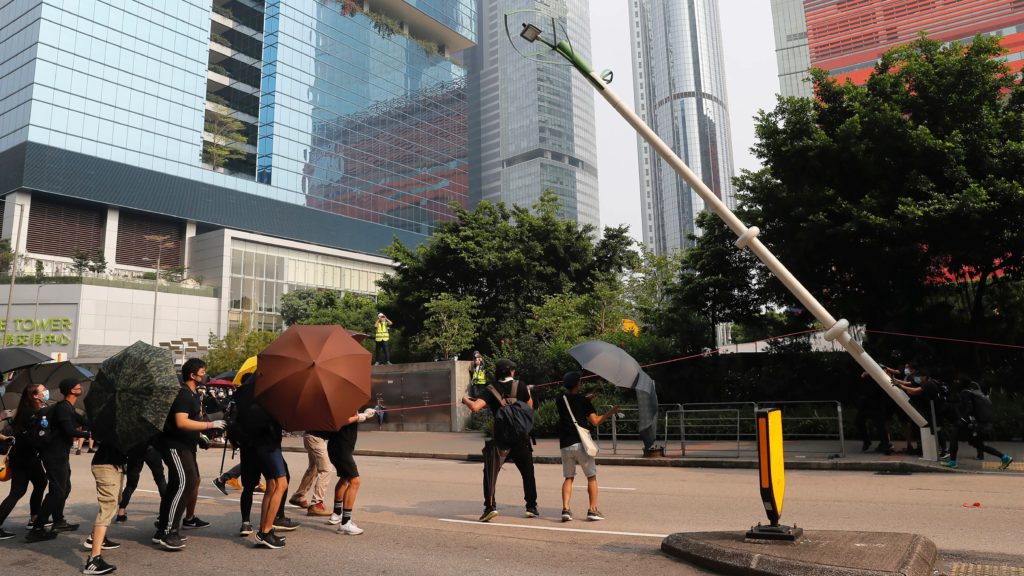
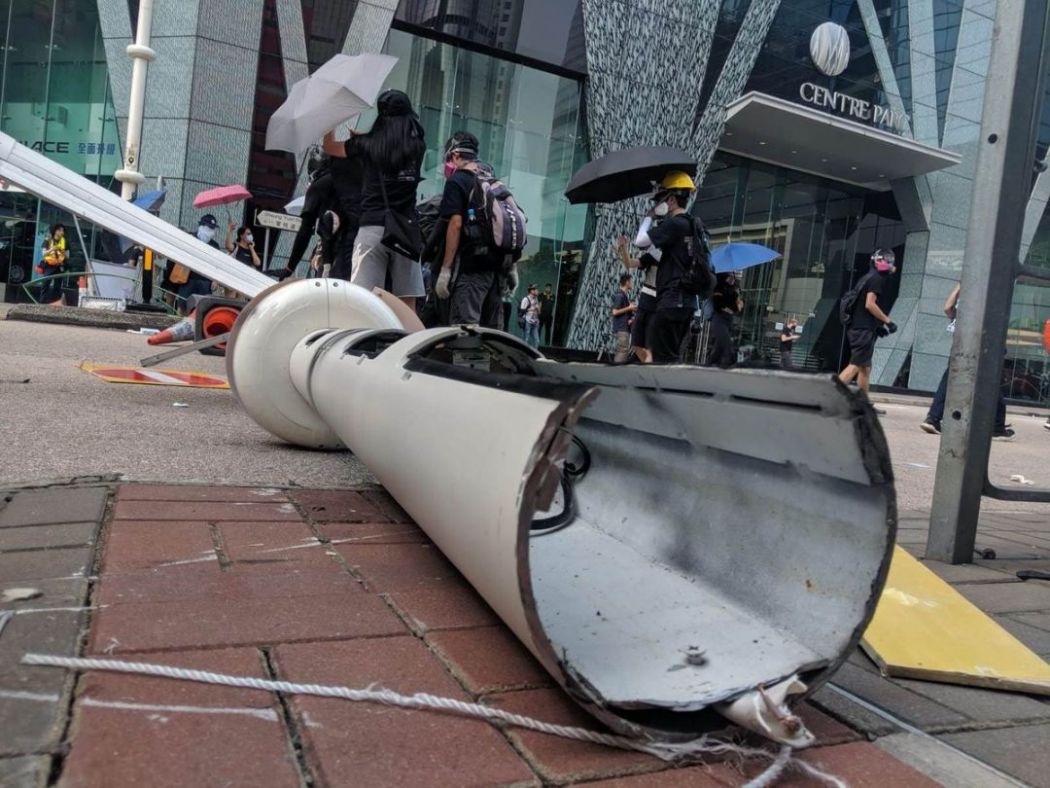
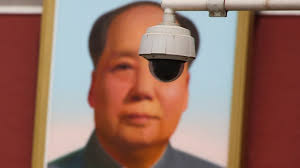

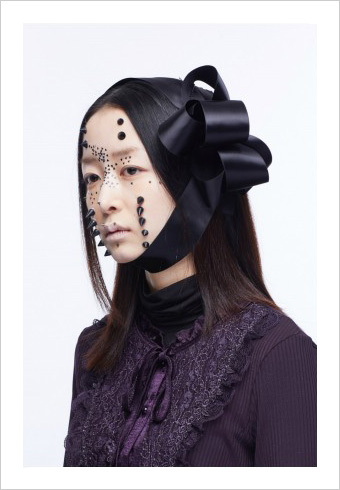


Leave a Reply